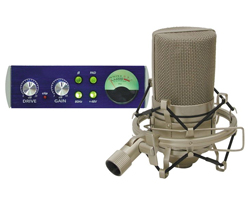Microphones and preamplifiers are the “chicken and egg” of audio. Want to start a discussion among audio folk? Ask whether mics or preamps are more important.
Later we’ll look at interviews with George Massenburg and John Hardy to get their take on transformer and transformerless preamps and solid state versus tubes. That’s the the main course.
But before we get to them, here’s a few appetizers.
Stronger Chains
For the entry-level engineer, getting better sound can be very frustrating. You may not be able to hear how great that new mic sounds until you get a better preamp.
Even then, if the mix bus or monitor section is the weakest link, the improvement won’t get to your ears. Even the cable can matter. Some colleagues and I were pained to find this out a number of years ago when comparing a Gefell mic with a Neumann U 87 and AKG C414.
In one studio, we got predictably different frequency responses, depending on whether we used the “house” cable, or Gotham GAC-3, or EMT 2022. Interesting, though, when we tried a similar test in another studio, the results were not so dramatic.
Why? Probably impedance differences. The first studio had a built-in wall panel and snake. The second didn’t. Was it the way the mics and snake interacted, or the way the snake and the first studio’s API console interacted. Or both?
The first studio used API console mic preamps, the second studio had an original issue Mackie 1604. Maybe the Mackie wasn’t open enough to pass the differences.
DIY Testing
`Want a simple way to test how responsive your chain is to improvement? Listen to a “humble” Shure SM58 through your existing chain, and then using the same microphone cable, plug the SM58 into your prospective new preamp and come in at line level to your mixer.
If you can’t hear a world of difference, the prospective preamp isn’t that much of an improvement or-and this is a BIG or-something else in the chain is eating up the improvement.
To Tube or Not to Tube?
Tube circuits are sometimes elevated into mythological status, primarily because they were all we had before solid state came along.
But the truth is that a good solid-state preamp sounds much better than a poorly designed tube preamp, and a good tube preamp sounds better than a poorly designed solid-state preamp.
It’s a pretty simple quality issue.
Having said that, if you’re working with audio that has a lot of transient material-the result of pretty much anything you record where you hit something-a tube circuit can “round off” the peaks of those transients less objectionably than a poorly designed solid state preamp which clips the transients. The plate of the tube absorbs some of the loudest transients.
Of course, that “rounding off” of the transient peaks is part of the coloration of the circuit, and technically, it’s distortion.




















